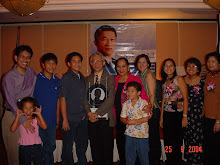MarketingRx for March 19-10
Sec Cabral's free condoms and effectiveness metrics for PR campaigns
By Dr Ned Roberto with Ardy Roberto
Q: Your recent column about measuring the effectiveness of advertising taglines was useful to me and my PR team. We're actually struggling with the same issue. Clients are asking us to be accountable for their PR budget. What we used to give them--news clippings, press releases, TV talk show guesting, and coverage in radio commentaries, etc-- are no longer enough. Clients want from us what they call "impact" and "response" data from the PR campaign's target audience. Does your advice about ad tagline effectiveness apply to us? How?
A: THERE ARE VERY FEW SIMILARITIES between a PR campaign and an advertising tagline. One obviously is that both are concerned with communication. But even as communication, the difference stands out against this narrow area of similarity.
As we've pointed out, consumers process ad taglines in their sub-conscious. PR campaigns are directed at the target consumer segment's conscious processing. So it follows that you should have your own metrics of target audience "impact" and "response" effectiveness. In crafting the suitable metrics, take your lead from that model of target consumer processing of the PR campaign message.
FREE CONDOMS case
Before you do this, there's another significant area of differentiation to consider. In the case of a PR campaign, market segment targeting is multiple. PR calls its target market segments as "stakeholder" segments. Consider the specific example of what happened to Health Secretary Esperanza Cabral when she took immediate action against the spread of HIV by authorizing the free distribution of condoms in call centers. (Reports say that she ordered US$8M worth of condoms!) It was in call centers where the DOH monitoring of HIV cases found the epidemic-like incidence of HIV infections.
If Sec Cabral were to commission your PR agency to help her, you would define her major target stakeholder segments to at least include those at high risks (i.e., the call center workers), and then the general public, the media, and the legislators. This is not to mention the "collateral" stakeholders that range over the Church and other religious organizations, the medical professionals, pharma companies, and so on. The impact on and the response to the free sampling of condoms by any one of these stakeholder segments will naturally differ depending on how each segment consider itself as Secretary Cabral's ally, oppositionist, or a neutral spectator to what's happening. What is known to have happened was that the Church took the role of oppositionist and demanded her resignation.
To lend focus and manageability to our diagnosis, let us consider the one key stakeholder segment that influence and shape other segments' responses to the emerging public issue. This key segment is the general public. Media responds according to how they see the general public will respond. And so with and even more will legislators similarly respond. This aligning of behavior will probably be true of all or most of the other stakeholder segments except for the Church who will predictably define its stand according to its own "teachings" about condom usage.
We now turn to your request for an effectiveness metric or metrics. If you will recall what you read about the ad tagline effectiveness, we did not go directly to the needed metric. Instead, we addressed first the issue of the required research from whose data the needed effectiveness metric or metrics will be derived. This is also true in your case.
Research
Start with the definition of the specific behavioral objective of the PR campaign for its targeted key stakeholder segment. To lend concreteness to the discussion, let's continue with Secretary Cabral's free-condoms case. For the general public, the PR campaign can seek to trigger the general public's expression of support for her continuing with the condom sampling. The campaign's call to action for such expression of support can be via SMS messages, emails, blog entries, rallies, signature campaigns and the like.
The validating research will be a sample survey of the general public quantifying the extent and duration of the different expressions of support. For scalability, an at-the-start-of-the-controversy survey and an at-end-of-the-campaign-period survey will provide unambiguous data showing how any one of the expressions of support increased over the duration of the campaign period, or reached early plateauing, or even declined. Probing the sample respondents for the reasons behind any of these data trends will uncover the depth or shallowness of the obtained support.
A persistent issue in this kind of effectiveness research for PR campaigns is this: "What about the campaign's multiple stakeholders? Should we not survey other stakeholders as well?" There are two opposing schools of thought here. One takes the position that other significant stakeholder segments should be surveyed. Its reason is that each stakeholder has its own position on the issue and this may differ from one segment to the next. The opposing camp believes that in the case such as Secretary Cabral's focusing is enough and even more than enough. That is focusing the research on the general public. The logic of this stand is as explained above. The general public's position on the issue shapes the stand of the other significant segments such as media, legislators, regulators, and enlightened civil societies.
So if you take the viewpoint of the former school, then be prepared for an expensive, high budget metricating research. If you elect the latter view, then you will obtain your effectiveness metrics with a cost-effective research budget. It's effective both in terms of money and time line for survey completion.









